Federico del Campo stands as a significant figure in late 19th and early 20th-century European art, celebrated primarily for his luminous and meticulously detailed paintings of Venice. A Peruvian by birth, he spent the most productive and recognized part of his career immersed in the unique atmosphere of the Italian lagoon city, becoming one of the foremost veduta painters of his generation. His works, highly sought after during his lifetime, particularly by affluent British and American travellers, continue to enchant viewers with their vibrant depiction of Venetian life, architecture, and the interplay of light and water. Del Campo successfully navigated the artistic currents of his time, blending the traditional precision of the Venetian view painting school with a brighter palette and atmospheric sensitivity that resonated with contemporary tastes. His life spanned a period of significant change, from the post-independence era of his native Peru to the bustling art markets of late Victorian and Edwardian Europe.
From Lima to the European Art Scene
Federico del Campo was born in Lima, the capital of Peru, in 1837. This places his formative years in the decades following Peru's independence from Spain, a period marked by political instability and the challenges of nation-building. While specific details about his early life and initial artistic training in Lima remain scarce, it is highly probable that he received foundational instruction within the artistic milieu of the capital. Like many ambitious artists from Latin America during the 19th century, Del Campo recognized that advancing his career and honing his skills required exposure to the established art centres of Europe. The continent offered prestigious academies, access to Old Master collections, and a competitive environment that fostered artistic growth.
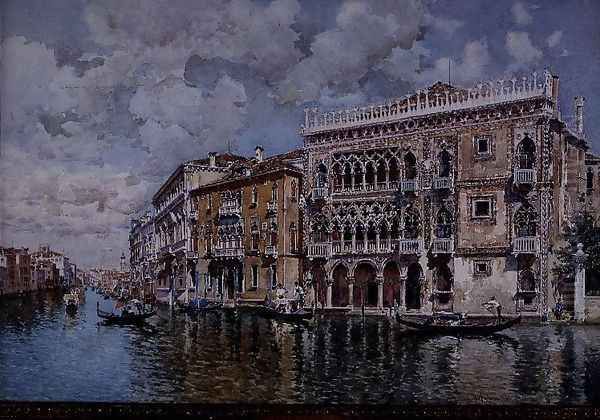
It is believed that Del Campo travelled to Europe to further his artistic education, a common trajectory for aspiring painters from the Americas seeking international recognition. Spain, with its historical ties to Peru and strong academic tradition, particularly at the Real Academia de Bellas Artes de San Fernando in Madrid, was a likely destination. Here, he could have studied the works of Spanish masters like Diego Velázquez and Francisco Goya, and potentially encountered contemporary Spanish artists. Paris and Rome were also crucial centres for artistic pilgrimage, offering diverse training opportunities and exposure to different movements, from Neoclassicism and Romanticism to the burgeoning Realist and Impressionist scenes. While the exact institutions or mentors Del Campo studied under are not definitively documented, his later work demonstrates a mastery of academic technique, particularly in draughtsmanship and perspective, suggesting a rigorous formal training.
The Enduring Spell of Venice
By the 1880s, Federico del Campo had established himself in Venice, a city that would become the central subject of his artistic output for the remainder of his career. Venice held an unparalleled allure for artists throughout the 19th century. Its unique urban landscape, built on water, offered a captivating interplay of architecture, reflections, and atmospheric effects. The city's rich history, its palpable sense of faded grandeur, and its vibrant daily life provided endless inspiration. Furthermore, Venice was a key destination on the Grand Tour circuit, attracting a steady stream of wealthy international visitors eager to acquire sophisticated souvenirs of their travels. This created a thriving market for high-quality view paintings, or vedute.
Del Campo immersed himself in this environment, dedicating his artistic practice almost exclusively to capturing the city's iconic landmarks and intimate corners. He set up a studio and became part of a community of artists, both Italian and expatriate, who were drawn to Venice's unique charms. His decision to specialize in Venetian scenes proved astute, aligning his exceptional technical skills with a subject matter that had both deep art historical roots and strong contemporary market appeal. He quickly gained recognition for his ability to render the city with remarkable clarity and beauty, appealing directly to the tastes of discerning collectors.
Heir to the Veduta Tradition
Federico del Campo consciously positioned himself within the great tradition of Venetian veduta painting, which had reached its zenith in the 18th century with masters like Giovanni Antonio Canal, better known as Canaletto, and Francesco Guardi. Canaletto was renowned for his precise, almost photographic depictions of Venetian topography, his masterful handling of perspective, and his clear, rational light. Guardi, while often depicting similar scenes, offered a more atmospheric and painterly interpretation, emphasizing fleeting effects of light and weather with a looser brushstroke. Del Campo drew inspiration from both.
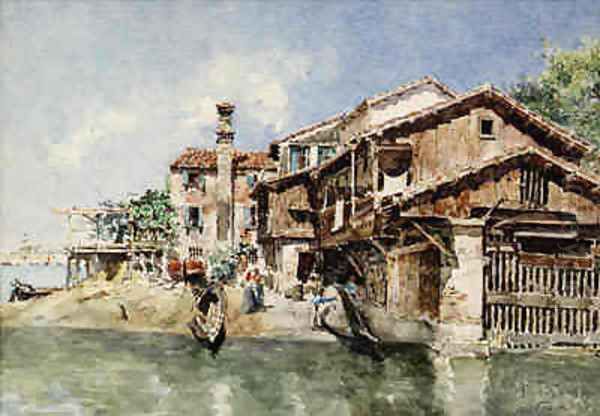
From Canaletto, Del Campo inherited a commitment to topographical accuracy and detailed rendering of architecture. His paintings often feature meticulous depictions of famous landmarks such as St. Mark's Basilica, the Doge's Palace, the Rialto Bridge, Santa Maria della Salute, and elegant palazzi lining the Grand Canal, like the Ca' d'Oro. He employed rigorous perspective to create convincing spatial depth and often included intricate details of architectural ornamentation. His compositions are typically well-structured and balanced, providing a clear and legible view of the scene. Other 18th-century vedutisti like Michele Marieschi and Canaletto's nephew, Bernardo Bellotto, had also contributed to this genre's vocabulary, emphasizing detailed cityscapes.
However, Del Campo's work is not merely a pastiche of his 18th-century predecessors. He infused the tradition with a sensibility shaped by 19th-century artistic developments. His palette is often brighter and more varied than Canaletto's, reflecting a greater interest in capturing the specific quality of Mediterranean light. While Guardi explored atmospheric effects, Del Campo achieved his sense of atmosphere through subtle modulations of colour and tone, particularly in his rendering of water and sky, often conveying the warmth and clarity of a sunny Venetian day. He found a balance between precise documentation and evocative portrayal that defined his unique contribution to the veduta genre.
A Modern Eye: Light, Colour, and Atmosphere
What distinguishes Federico del Campo's Venetian views is his exceptional sensitivity to light and atmosphere, rendered with a clarity and brilliance that felt distinctly modern to his contemporaries. He excelled at capturing the dazzling effects of sunlight on stone, water, and the colourful stucco of Venetian buildings. His skies are often a luminous cerulean blue, and the canals shimmer with complex reflections, mirroring the adjacent architecture and the bustling boat traffic. This focus on light aligns his work, in spirit if not always in technique, with some aspects of Impressionism, although he never fully abandoned representational detail for the broken brushwork characteristic of core French Impressionists like Claude Monet, who also famously painted Venice later in his career.
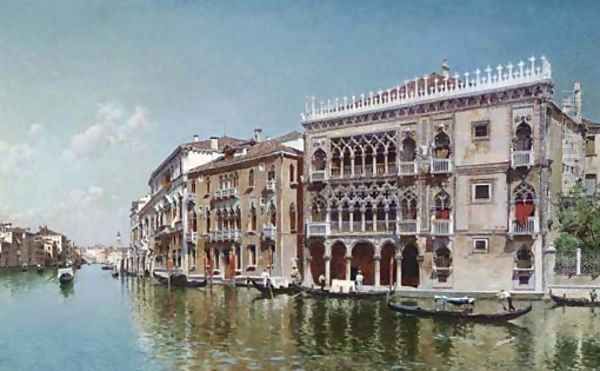
Del Campo's technique involved careful observation, likely supplemented by plein air sketching to capture immediate light effects and colours accurately. However, the high degree of finish and meticulous detail in his paintings suggest that they were completed in the studio. He paid close attention to the textures of materials – the weathered stone of ancient buildings, the smooth glide of gondolas, the gentle ripples on the water's surface. His figures, often populating the scenes as gondoliers, merchants, or elegantly dressed citizens and tourists, are rendered with enough detail to add life and scale without distracting from the overall architectural focus. His use of colour is both descriptive and evocative, employing vibrant hues for sails, awnings, or figures' clothing, which stand out against the more muted tones of stone and water, adding visual interest and enhancing the sense of vitality. This careful balance between topographical accuracy and painterly vibrancy became his signature style.
Venetian Contemporaries and Collaborators
During his time in Venice, Federico del Campo became part of a vibrant community of artists, particularly connecting with fellow expatriates from Spain. His closest association was with Martin Rico y Ortega (1833-1908), a highly regarded Spanish landscape and cityscape painter who also spent considerable time in Venice. Rico y Ortega shared Del Campo's interest in capturing the light and atmosphere of the city, often working with a similarly bright palette and detailed finish, though sometimes with a slightly looser, more fluid brushstroke. Sources indicate that the two artists were good friends and may have occasionally collaborated or shared studio space, responding to the high demand for Venetian scenes. Their works, while distinct, often share a common sensibility, celebrating the picturesque beauty of Venice in a manner that appealed strongly to the international market.
Del Campo also moved within the circles of other notable Spanish artists active in Italy, such as Mariano Fortuny y Marsal (1838-1874), whose brilliant technique and Orientalist subjects earned him immense fame before his early death, and Rafael Senet y Pérez (1856-1926), another painter known for his luminous views of Venice and other Italian locations. This Spanish contingent brought a particular flair and technical brilliance to the Italian art scene.
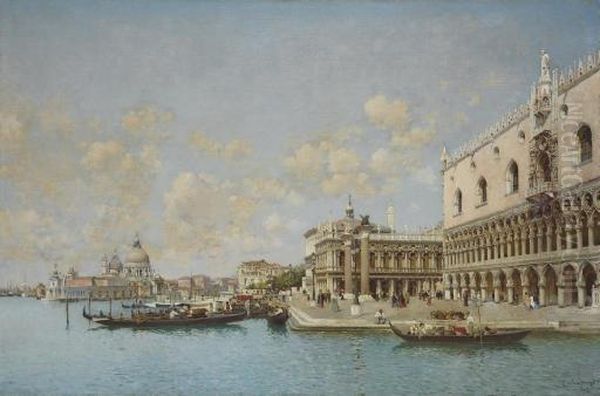
Beyond the Spanish circle, Del Campo worked alongside numerous Italian artists specializing in Venetian views, such as Guglielmo Ciardi (1842-1917), known for his atmospheric lagoon scenes, Ippolito Caffi (1809-1866), an earlier 19th-century master of perspective and dramatic light effects in his vedute, and Luigi Querena (1824-1887). While Del Campo's style remained distinct, he was undoubtedly aware of and interacting within this broader artistic context. Furthermore, Venice attracted major international artists during this period. Americans John Singer Sargent (1856-1925) and James McNeill Whistler (1834-1903) produced famous series of Venetian works, often exploring more impressionistic or tonalist interpretations, offering a contrast to Del Campo's detailed realism. Other major European figures like the Italian portraitist Giovanni Boldini (1842-1931) and the Spanish master of light Joaquín Sorolla (1863-1923), though not primarily veduta painters, were contemporaries whose work reflected the era's fascination with capturing light and modern life. Del Campo's specific niche was firmly within the detailed, sunlit veduta, but he operated within this rich and diverse artistic landscape.
Masterpieces of the Lagoon
Federico del Campo's oeuvre consists primarily of Venetian views, often revisited themes and locations rendered with consistently high quality. Among his representative works, several stand out:
Ca' d'Oro, Venice (versions exist, including one dated 1885): This painting showcases Del Campo's skill in rendering one of Venice's most celebrated Gothic palaces on the Grand Canal. He meticulously captures the intricate tracery of the facade, the polychrome marble decorations, and the delicate reflections of the building in the water below. The painting typically includes gondolas passing by, adding a sense of scale and daily life to the architectural portrait. The clear, bright light emphasizes the richness of the materials and the elegance of the structure.
Canal in Venice (numerous variations): This title encompasses many of Del Campo's works depicting smaller, less monumental canals. These scenes often focus on the interplay of light and shadow across narrow waterways, the textures of weathered buildings, arched bridges, and the ubiquitous presence of gondolas. They capture the intimate charm of Venice away from the grand public spaces, highlighting the picturesque quality of everyday life in the city. The clarity of the water and the vibrancy of incidental details, like laundry hanging from windows or figures conversing on steps, are characteristic.
Il Squerro di San Trovaso, Venice: This subject depicts one of the few remaining gondola boatyards (squeri) in Venice. Del Campo was drawn to this working aspect of the city, capturing the rustic wooden structures of the yard, the gondolas in various states of construction or repair, and the artisans at work. These paintings offer a glimpse into the traditional crafts underpinning Venetian life, rendered with the same precision and attention to light found in his views of grander landmarks.
Capri Scene: While overwhelmingly focused on Venice, Del Campo occasionally painted other locations. The mention of a Capri Scene indicates his travels and willingness to apply his skills to different landscapes. Capri, with its dramatic coastline and brilliant Mediterranean light, offered a different kind of picturesque beauty, suggesting Del Campo's broader capabilities as a landscape and cityscape painter, though Venice remained his true artistic home.
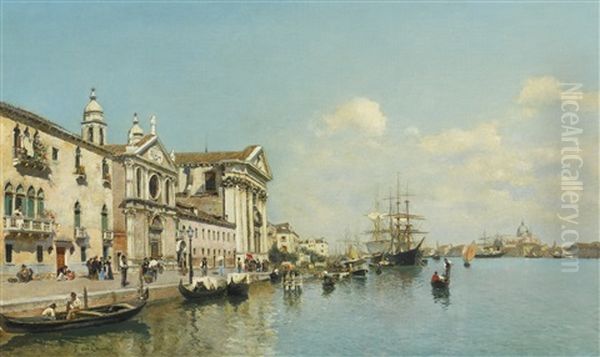
These works, and many others like them depicting the Grand Canal, the Riva degli Schiavoni, the Salute, or St. Mark's Square, exemplify Del Campo's consistent style: a combination of detailed realism, luminous colour, and an idealized yet convincing portrayal of Venice that proved immensely popular.
Success and International Acclaim
Federico del Campo achieved considerable commercial success during his lifetime. His paintings perfectly matched the desires of the burgeoning tourist market, particularly affluent British and American visitors undertaking the Grand Tour or seeking sophisticated mementos of their travels. His detailed, recognizable, and beautifully executed views of Venice served as ideal acquisitions. His work was praised for its technical skill and its ability to capture the unique charm and beauty of the city. Contemporary reviews noted the "clearness and great transparency" of his work, highlighting the qualities that appealed to collectors.
His success was significantly aided by his relationship with prominent international art dealers, most notably Arthur Tooth & Sons of London. Tooth was a major dealer with galleries in London and Paris, specializing in contemporary European art that appealed to British tastes. Representing Del Campo, Tooth organized exhibitions and facilitated sales, bringing the artist's work to a wider, appreciative audience. A special exhibition of Del Campo's paintings organized by Tooth during the World's Columbian Exposition in Chicago in 1893 marked a high point in his international recognition. This exposure in the United States further solidified his reputation and market appeal.
Del Campo's paintings entered numerous important private collections, including those of British aristocracy and even royalty. Works by him were reportedly held in prestigious collections such as those at Buckingham Palace and Windsor Castle, attesting to the high regard in which his art was held. This level of patronage ensured Del Campo a comfortable lifestyle and cemented his status as one of the leading veduta painters of his time. His success story reflects both his artistic talent and his ability to connect with the prevailing tastes and economic conditions of the late 19th-century art market.
The London Connection
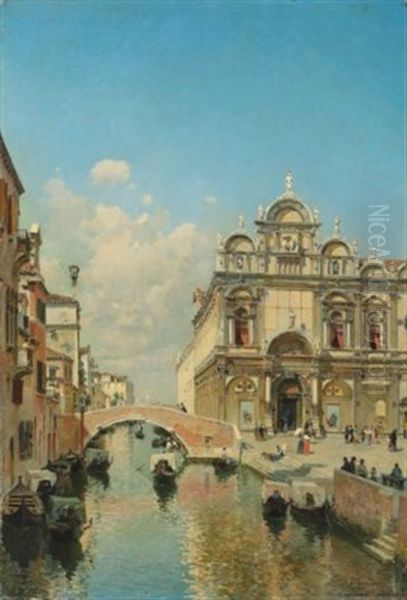
In 1893, the same year as his successful showing at the Chicago Exposition, Federico del Campo reportedly moved his primary residence from Venice to London. London at this time was arguably the centre of the global art market, offering artists access to wealthy patrons, influential dealers, and prestigious exhibition venues. His association with Arthur Tooth & Sons likely played a role in this decision, allowing him to be closer to his main dealer and the lucrative British market.
Despite relocating to London, Del Campo's artistic focus remained firmly fixed on Venice. It is probable that he continued to travel frequently to the Italian city to sketch and gather material for his paintings, which he would then complete in his London studio. The fact that he is documented as still residing in Venice as late as 1919 suggests either extended stays or perhaps maintaining dual residences or studios for a period. London provided the commercial and logistical base for his international career, while Venice remained his inexhaustible source of inspiration. He continued to produce Venetian scenes throughout his later years, maintaining the high standards of detail and luminosity that had established his reputation.
Final Years and Enduring Legacy
Federico del Campo continued to paint and exhibit his Venetian views well into the early 20th century. He passed away in London in 1923, having lived a long and productive life dedicated to his art. He left behind a substantial body of work that continues to be admired for its technical brilliance and evocative beauty.
His legacy lies in his position as one of the last great traditional veduta painters, working at a time when artistic styles were rapidly diversifying towards Modernism. He successfully adapted the meticulous approach of 18th-century masters like Canaletto to the sensibilities of the late 19th century, incorporating a brighter palette and a heightened sensitivity to light and atmosphere that resonated with contemporary audiences. While perhaps not an innovator in the mould of the Impressionists or Post-Impressionists, Del Campo perfected a specific vision of Venice – sunlit, picturesque, detailed, and enduringly romantic.
His paintings serve as exquisite documents of Venice during a particular era, capturing not only its famous architecture but also the lifeblood of its canals and the unique quality of its light. The continued demand for his works at auction and their presence in museum collections and prestigious private hands around the world attest to his lasting appeal. Federico del Campo remains celebrated for his ability to transport viewers to the luminous waterways and squares of Venice, captured with unparalleled clarity and charm by a master craftsman who dedicated his life to portraying the city he loved.